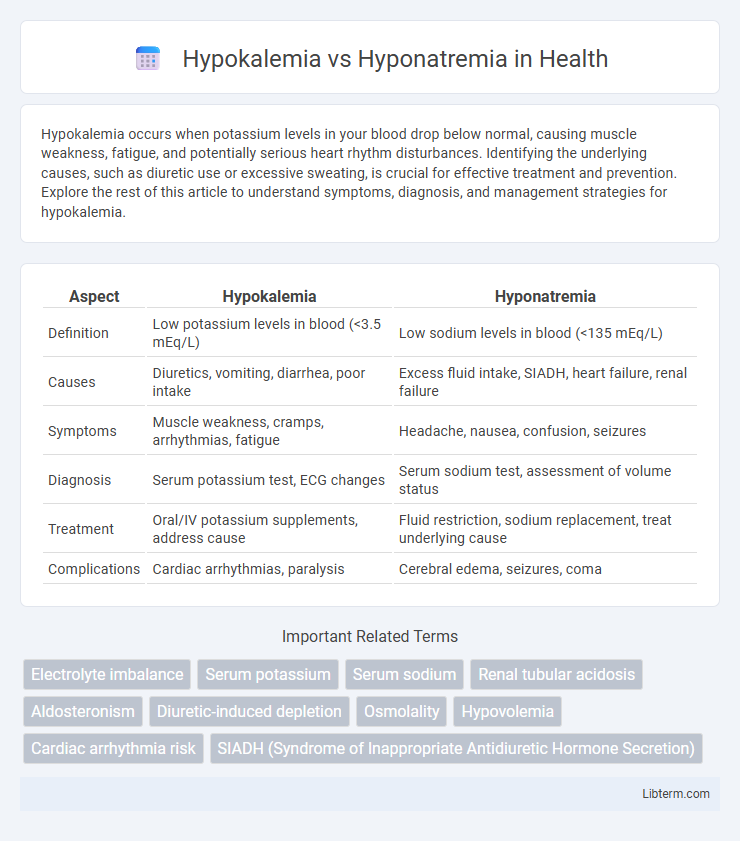Hypokalemia occurs when potassium levels in your blood drop below normal, causing muscle weakness, fatigue, and potentially serious heart rhythm disturbances. Identifying the underlying causes, such as diuretic use or excessive sweating, is crucial for effective treatment and prevention. Explore the rest of this article to understand symptoms, diagnosis, and management strategies for hypokalemia.
Table of Comparison
| Aspect | Hypokalemia | Hyponatremia |
|---|---|---|
| Definition | Low potassium levels in blood (<3.5 mEq/L) | Low sodium levels in blood (<135 mEq/L) |
| Causes | Diuretics, vomiting, diarrhea, poor intake | Excess fluid intake, SIADH, heart failure, renal failure |
| Symptoms | Muscle weakness, cramps, arrhythmias, fatigue | Headache, nausea, confusion, seizures |
| Diagnosis | Serum potassium test, ECG changes | Serum sodium test, assessment of volume status |
| Treatment | Oral/IV potassium supplements, address cause | Fluid restriction, sodium replacement, treat underlying cause |
| Complications | Cardiac arrhythmias, paralysis | Cerebral edema, seizures, coma |
Introduction to Electrolyte Imbalances
Electrolyte imbalances such as hypokalemia and hyponatremia disrupt critical physiological functions by altering potassium and sodium levels in the blood. Hypokalemia is characterized by a serum potassium concentration below 3.5 mEq/L, impairing muscle function and cardiac rhythm, while hyponatremia involves serum sodium levels under 135 mEq/L, leading to neurological symptoms due to cerebral edema. Both conditions require prompt diagnosis and management to restore electrolyte homeostasis and prevent severe complications.
Understanding Hypokalemia: Causes and Symptoms
Hypokalemia, characterized by low potassium levels in the blood, often results from diuretic use, excessive sweating, diarrhea, or inadequate dietary potassium intake. Key symptoms include muscle weakness, cramps, fatigue, and cardiac arrhythmias, which can lead to severe complications if untreated. Differentiating hypokalemia from hyponatremia, which involves low sodium levels, is crucial since their causes and management strategies differ significantly.
Overview of Hyponatremia: Etiology and Indicators
Hyponatremia is characterized by a serum sodium concentration below 135 mEq/L, often resulting from excessive water retention, sodium loss, or a combination of both. Common etiologies include heart failure, liver cirrhosis, syndrome of inappropriate antidiuretic hormone secretion (SIADH), and diuretic use. Clinical indicators of hyponatremia involve nausea, headache, confusion, seizures, and in severe cases, coma, reflecting the effects of cellular swelling due to hypo-osmolality.
Key Differences Between Hypokalemia and Hyponatremia
Hypokalemia involves low potassium levels in the blood, typically below 3.5 mEq/L, while hyponatremia is characterized by low sodium levels, usually under 135 mEq/L. Hypokalemia often causes muscle weakness, cramps, and cardiac arrhythmias, whereas hyponatremia primarily leads to neurological symptoms such as headache, confusion, and seizures. The underlying causes also differ: hypokalemia commonly results from diuretic use, excessive vomiting, or diarrhea, while hyponatremia is often due to excessive fluid intake, heart failure, or syndrome of inappropriate antidiuretic hormone secretion (SIADH).
Common Risk Factors and Underlying Conditions
Hypokalemia and hyponatremia share common risk factors, including diuretic use, excessive fluid intake, and gastrointestinal losses such as vomiting or diarrhea. Underlying conditions like heart failure, chronic kidney disease, and adrenal insufficiency often contribute to electrolyte imbalances in both disorders. Identifying these overlapping factors is crucial for accurate diagnosis and effective management of the respective electrolyte disturbances.
Clinical Manifestations: How Symptoms Vary
Hypokalemia primarily presents with muscle weakness, cramps, and cardiac arrhythmias due to impaired neuromuscular function and altered cardiac conduction. Hyponatremia manifests as headache, nausea, confusion, seizures, and in severe cases, coma, resulting from cerebral edema caused by decreased serum sodium levels. Differentiating these electrolyte imbalances clinically hinges on neurological symptoms predominating in hyponatremia and muscular and cardiac symptoms in hypokalemia.
Diagnostic Approaches for Accurate Differentiation
Diagnosing hypokalemia versus hyponatremia involves precise measurement of serum electrolyte concentrations, with potassium levels below 3.5 mEq/L indicating hypokalemia and sodium levels under 135 mEq/L confirming hyponatremia. Urine electrolyte analysis and osmolality tests provide critical insights, where low urine sodium suggests hypovolemic hyponatremia, and high urine potassium helps identify renal potassium loss in hypokalemia. Comprehensive evaluation of clinical presentation combined with laboratory data enables targeted treatment strategies for these distinct electrolyte disturbances.
Standard Treatment Strategies for Each Condition
Hypokalemia treatment primarily involves potassium supplementation through oral or intravenous routes, alongside addressing underlying causes such as diuretic use or gastrointestinal losses. Hyponatremia management depends on severity and etiology, with options including fluid restriction for mild cases, hypertonic saline administration for severe symptomatic hyponatremia, and correction of underlying disorders like syndrome of inappropriate antidiuretic hormone secretion (SIADH). Both conditions require careful monitoring of electrolyte levels to prevent complications during therapy.
Prevention and Management Tips
Prevention of hypokalemia involves a balanced diet rich in potassium from sources like bananas, oranges, and spinach, while avoiding excessive diuretic use and monitoring electrolyte levels in at-risk patients. Managing hyponatremia requires careful fluid intake regulation, treating underlying causes such as heart failure or SIADH, and closely monitoring serum sodium to prevent rapid correction that can lead to central pontine myelinolysis. Both conditions benefit from regular laboratory assessments and individualized treatment plans to maintain optimal electrolyte balance and prevent complications.
Frequently Asked Questions on Hypokalemia vs Hyponatremia
Hypokalemia and hyponatremia both involve electrolyte imbalances but differ in causes and symptoms; hypokalemia is characterized by low potassium levels leading to muscle weakness and arrhythmias, while hyponatremia involves low sodium levels causing confusion and seizures. Common questions address the primary causes such as diuretic use for hypokalemia and excessive water intake or SIADH for hyponatremia, along with treatment strategies emphasizing potassium or sodium replacement. Diagnosis relies on serum electrolyte tests, and management requires careful balancing to prevent complications like cardiac arrest or cerebral edema.
Hypokalemia Infographic

 libterm.com
libterm.com